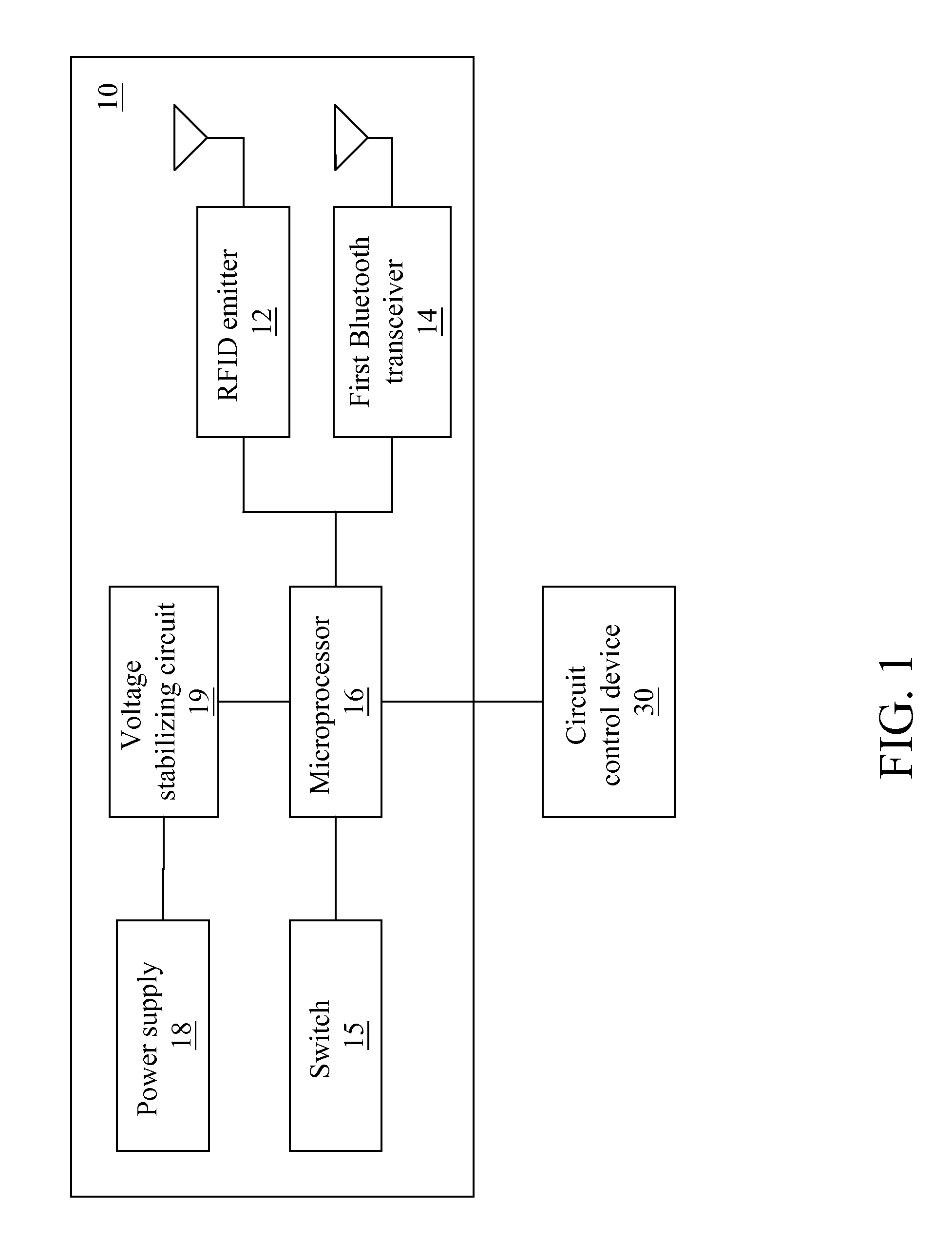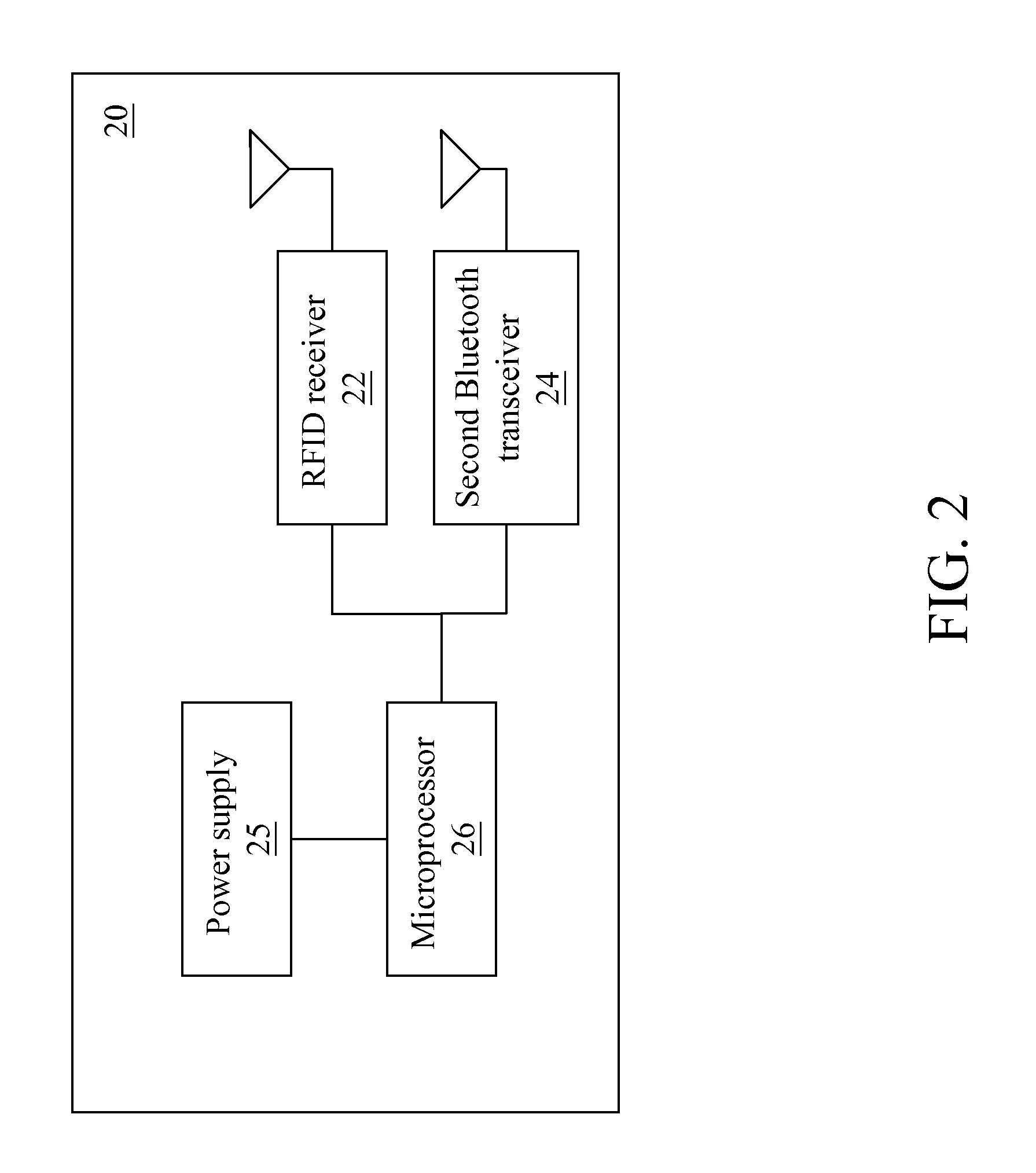Non-contact control method and device
a non-contact control and control method technology, applied in the direction of anti-theft devices, program control, instruments, etc., can solve the problems of non-contact latch tools that vehicle doors are and non-contact latch tools cannot be easily damaged by external force and opened. , to achieve the effect of reducing the probability of being pirated, saving power consumption, and improving use security
- Summary
- Abstract
- Description
- Claims
- Application Information
AI Technical Summary
Benefits of technology
Problems solved by technology
Method used
Image
Examples
first embodiment
[0027]FIG. 2 is a system block diagram of a slave control module. Referring to FIG. 2, the slave control module 20 comprises an RFID receiver 22 (a second RFID component), a second Bluetooth transceiver 24 (a second Bluetooth component), and a second microprocessor 26.
[0028]The slave control module 20 is disposed in a non-contact key, and is used to interact with a master control module 10.
[0029]Power of the slave control module 20 is supplied by a power supply 25. The power supply 25 is powered by a common battery, and the power is converted by a direct current (DC) / DC and then is supplied to the slave control module 20.
[0030]The RFID receiver 22 is an RFID tag. The second Bluetooth transceiver 24 is a wireless transmission element satisfying Bluetooth communication specifications. The RFID receiver 22, the second Bluetooth transceiver 24, and the second microprocessor 26 can be integrated into an SOC IC, or each is an individual IC.
[0031]The second microprocessor 26 is electricall...
second embodiment
[0033]FIG. 3 is a system block diagram of a slave control module. Referring to FIG. 3, the slave control module 20 comprises an RFID receiver 22, a second Bluetooth transceiver 24, a second microprocessor 26, a power supply 25, and a key 28.
[0034]In this embodiment, in a state that a user is allowed to start a vehicle, after the user presses down the key 28, the slave control module 20 controls the master control module 10 to operate in a pairable mode. In the pairable mode, the first Bluetooth transceiver 14 of the master control module 10 is paired with a device with another Bluetooth transceiver. After being paired, the device with another Bluetooth transceiver has an unlocking authority and serves as a backup key. The device with the Bluetooth transceiver is, for example, a mobile phone or a personal digital assistant (PDA).
third embodiment
[0035]FIG. 4 is a system block diagram of a slave control module. Referring to FIG. 4, the slave control module 20 comprises an RFID receiver 22, and second Bluetooth transceiver 24, a second microprocessor 26, a power supply 25, a key 28, and an indicating lamp 29.
[0036]Furthermore, the slave control module 20 reads a pairing parameter. The pairing parameter comprises, for example, (1) whether another Bluetooth transceiver requires inputting a password; (2) a quantity and a priority of another Bluetooth transceiver capable of being paired; (3) whether vehicle information is allowed to be transmitted to another Bluetooth transceiver.
[0037]When the second microprocessor 26 detects that a voltage supplied by the power supply 25 is lower than a critical value, the indicating lamp 29 continuously flickers, so as to remind the user to replace the battery.
[0038]FIGS. 1 to 4 illustrate hardware architectures of the master control module 10 and the slave control module 20. For the detailed ...
PUM
 Login to View More
Login to View More Abstract
Description
Claims
Application Information
 Login to View More
Login to View More - R&D
- Intellectual Property
- Life Sciences
- Materials
- Tech Scout
- Unparalleled Data Quality
- Higher Quality Content
- 60% Fewer Hallucinations
Browse by: Latest US Patents, China's latest patents, Technical Efficacy Thesaurus, Application Domain, Technology Topic, Popular Technical Reports.
© 2025 PatSnap. All rights reserved.Legal|Privacy policy|Modern Slavery Act Transparency Statement|Sitemap|About US| Contact US: help@patsnap.com



